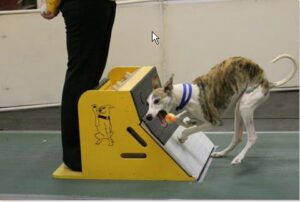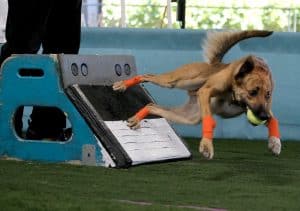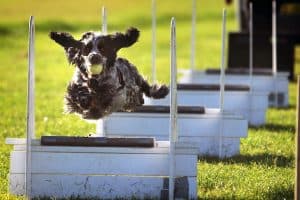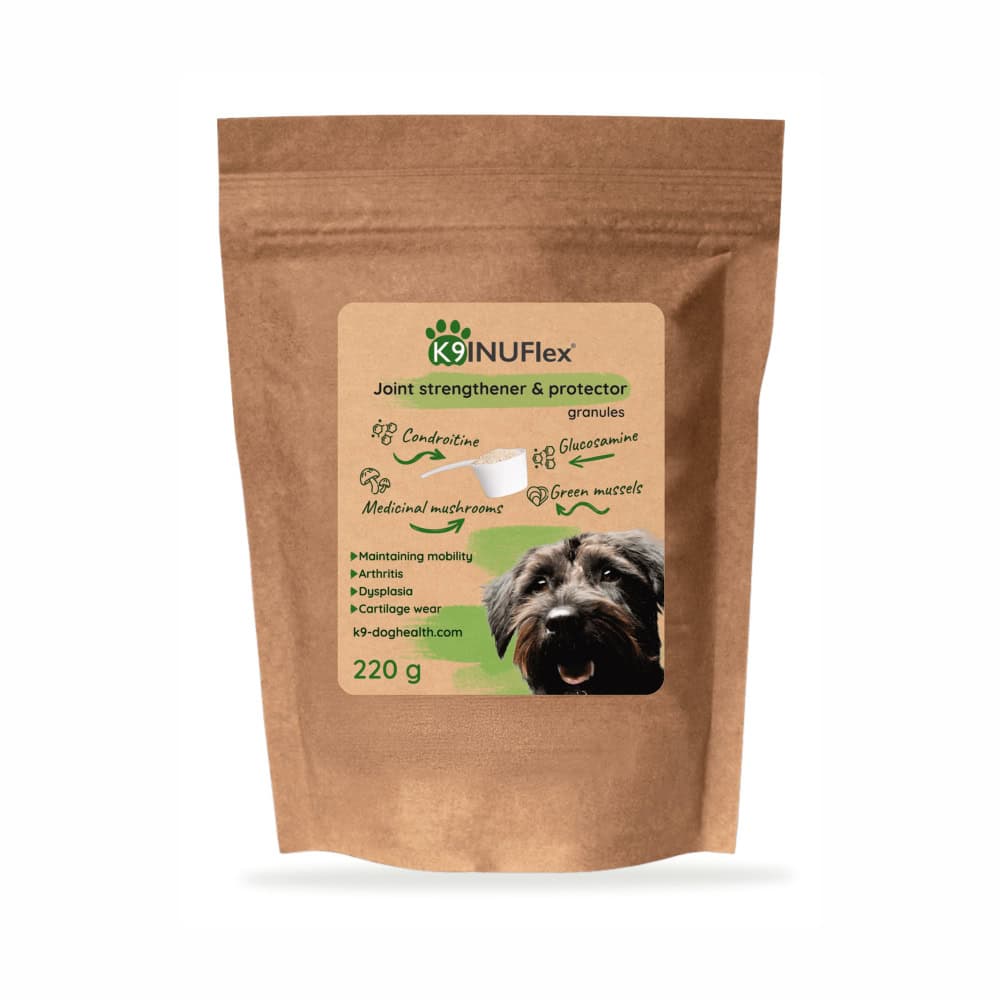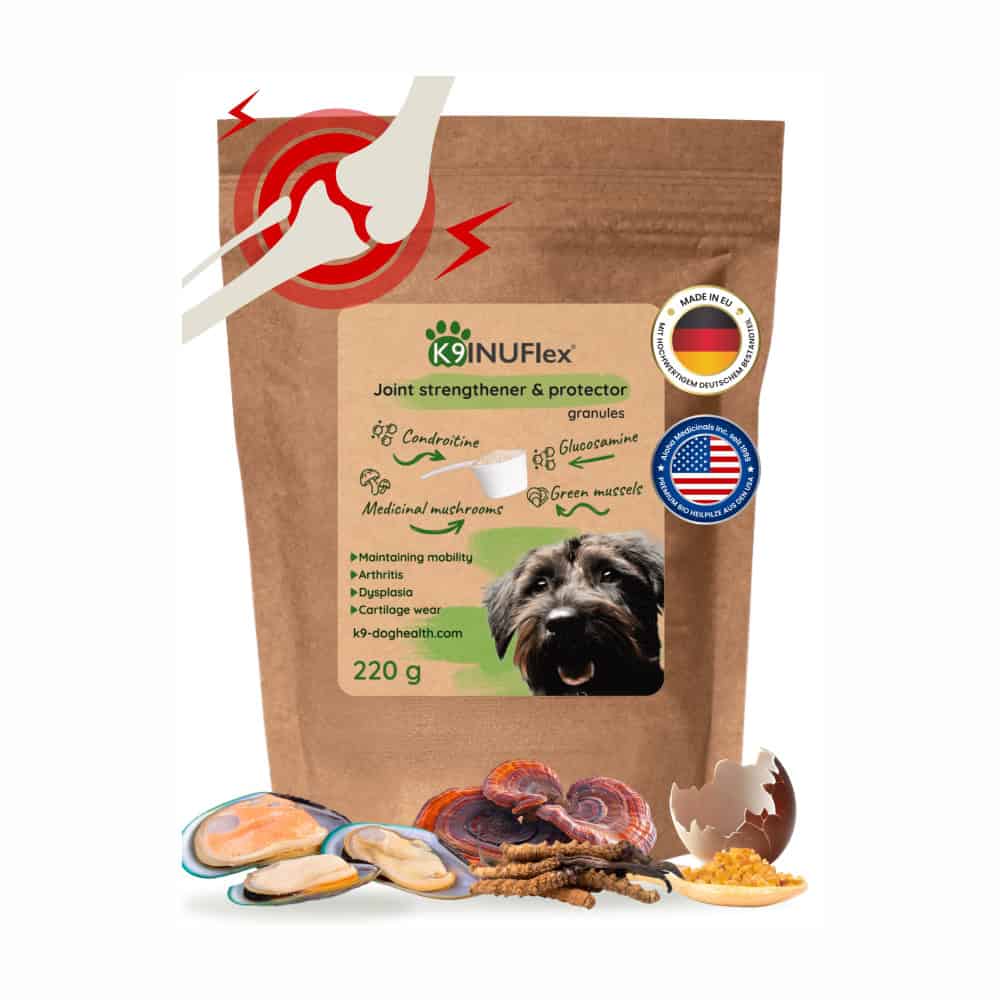Flyball took off when Herbert Wagner, in 1970, introduced his tennis ball launcher and the dog that retrieved the ball during an episode of the Johnny Carson Show. Shortly after, dog trainers and canine clubs began using the device.
Dog lovers in the Toronto–Detroit area first started practicing flyball as a sport, and dogs clearly enjoyed the fun. Soon after, enthusiasts established the North American Flyball Association (NAFA), which became the leading organization for flyball clubs worldwide. After organizing a few local events, they held the first major Flyball competition in 1983.
How Flyball is played
Two teams, each consisting of two to four dogs, compete on two parallel 15-16 meter (51-foot) long lanes. The dogs take turns clearing four hurdles and then retrieve a ball from the flyball machine. After obtaining the ball, they must return it to the starting point, passing through the previously completed four hurdles. The next dog can start as soon as the previous one crosses the start/finish line. The dogs must complete the task without errors and as quickly as possible.
Organizers usually run tournaments in pairs or in a round robin format. They award prizes to the top 3 or 5 teams in doubles races. In round robin races, they award the top 3 teams out of the 5 best performing ones.
Judges adjust the height of the hurdles to match the smallest dog in the team of four. They set the height 10 cm (4 inches) lower than the smallest dog’s shoulder. The minimum jump height is 20 cm (8 inches), and the maximum is 40 cm (16 inches).
How to Teach Flyball
You don’t necessarily need a flyball machine to teach your dog the basics of flyball. You can train your dog at home to perform the movements required for the sport, whether for practice or competition.
- First and foremost, you should have your dog’s obedience training at a certain level, including a reliable recall command.
- The next step is to teach your dog how to retrieve (apport). If your dog hasn’t learned this skill yet, it’s best to start teaching it in a controlled environment like a hallway or foyer. This minimizes distractions, prevents your dog from wandering off, and keeps their focus on you and the ball. Training in a hallway also simulates the straight path of a flyball run, helping your dog get used to running in a straight line from the machine to you.
Roll the ball, and as soon as your dog pounces on it, call them back to you immediately. When they return, reward them with something they really like (a treat, tug-of-war with a cloth, etc.). It’s important to start with short distances and take small breaks between tosses. After a successful return or two, engage in a different activity with your dog, like playing with a toy or letting them sniff around. Make this game varied and enjoyable so that your dog develops a fondness for it!
Use command words
from the beginning that you’ll also use during real flyball games, such as “run” or “fetch.” After your dog retrieves the ball, call them back immediately. Typically, using their name works best to call them. When your dog returns, reward them with something they really like (a treat, tug-of-war with a cloth, etc.). It’s essential to start with short distances and take small breaks between tosses. After a successful return or two, you can introduce a command that signals to your dog that they can go for the ball shortly, like “Ready!” Hold the ball in front of you, roll it, prepare your dog to go (“Ready!”), and when the ball is almost stationary, release your dog with the command “Fetch.”
Ensure your dog runs back to you at the same speed as they ran toward the ball. You can achieve this by continuously encouraging them. When your dog reaches you, be sure to reward them with another ball, a treat, or their favorite toy. Let your dog move freely while you play together, and keep the activity fun so they stay engaged.
Once your dog is proficient at this, you can gradually introduce the concept of jumping over obstacles with a ball in their mouth. Set up a very low jump obstacle in the middle of your hallway or room to help them learn how to run through obstacles towards the flyball machine and back. Play with balls of various sizes and materials so your dog gets used to the idea that the same task applies to all types of balls.
Flyball Machines
A flyball machine consists of a launching mechanism that shoots the ball in a suitable arc, height, and speed for the dog to easily catch it in the air. Older versions of the machine used a catapult mechanism. The dog stepped on a pedal, triggering the catapult, and the dog—ideally—waited for the ball to be launched at an appropriate distance for them to catch it.
These older models are rarely used anymore due to safety concerns, as they posed a risk to dogs. While you might still encounter them occasionally, newer (American-style) machines are the standard in competitions.
The evolution of these machines also led to significant changes in training methods over the past decade. The newer machines are wider and larger, with the launching mechanism placed inside the machine, making it less hazardous for the dogs. The machine’s design prevents the dog’s momentum from breaking when they stop and press a pedal with one paw. The entire front part of the machine functions as the pedal, allowing the dog to perform a swim turn technique without losing speed. This technique not only minimizes speed loss but also protects the dog’s joints, especially their shoulders, from injuries.
These are the basics of flyball, and you can teach them to your dog with just a ball and a lot of patience. If your dog enjoys playing with a ball and learns how to retrieve it as required in flyball, teaching them to use the machine will be a breeze.
Whatever sport you do with your dog, it’s a good idea to use supplements to help alleviate the increased physical strain.
Check out our Hip & Joint support products.
